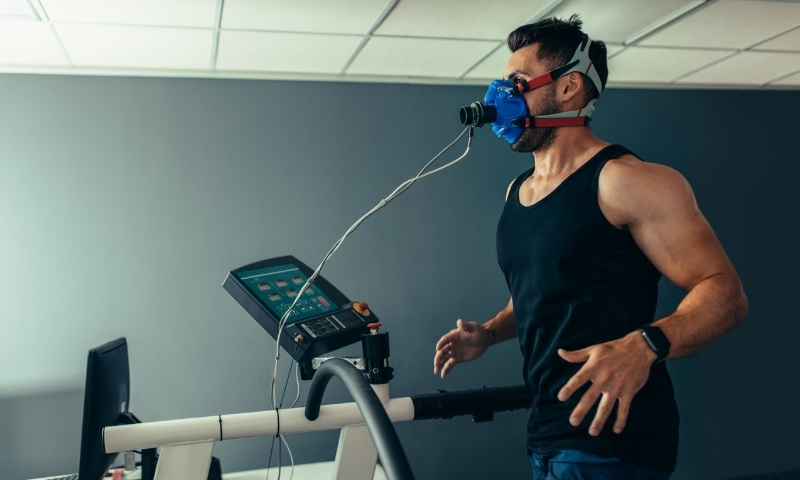5 Ways to Improve Your VO2 Max Without Running
VO2 max (maximal oxygen uptake) might sound like something straight out of an Olympic training manual. But you don’t need to be a pro athlete to boost it, or benefit from it.
It’s one of the best markers of your overall fitness and long-term health.
And no, improving it doesn’t mean you have to become a cardio junkie or start clocking 10 miles a day.
If running isn’t your vibe or your knees are staging a protest, I’ve got you. Let’s break down how to boost your VO2 max in ways that work for your body.
Key Takeaways
- VO2 max measures how well your body uses oxygen during exercise. The higher it is, the fitter you are.
- You don’t have to run to improve it. Low-impact options work too.
- HIIT is one of the fastest ways to boost VO2 max; even just a few minutes a day can help.
- Mix it up with both HIIT and moderate workouts to build endurance and improve oxygen use.
- Stay consistent and build gradually to see real progress.
A Quick Overview of VO2 Max
VO2 max is your body’s peak ability to absorb and use oxygen during exercise. In simpler terms, it shows how well your heart, lungs, and muscles work together to keep you moving.
Think of it as your body’s version of aerobic horsepower. The higher it is, the more energy you’ll have for daily tasks like climbing stairs or pushing through a tough workout without feeling wiped.
And the benefits go way beyond fitness. Improving your VO2 max may help:
- Lower risk of chronic disorders like heart disease, stroke, diabetes, and cancer
- Improve energy, focus, and mood
- Help you sleep better
- May support a longer, healthier life
Yep, research shows that better cardiorespiratory fitness is linked to a lower risk of serious health issues over time.
But here’s where it gets even more valuable: your VO2 max score can also flag underlying imbalances that might be limiting your progress, like hormonal shifts, poor mitochondrial function, or low oxygen delivery. It’s also something that can reduce over time.
That’s why, at Young Wellness Center, we use VO2 max data to guide smart, targeted interventions, such as hormone replacement therapy (HRT), IV support, or even Hyperbaric Oxygen Therapy (HBOT) when needed.
Now, the big question: how do you improve your VO2 max?
You’ve probably heard the usual answer: go for a run. And sure, running works. But if you’re not into marathons (or your knees aren’t a fan of it), there are better options.

1. Try High-Intensity Interval Training (HIIT)
Tired of long, boring treadmill sessions? HIIT (High-Intensity Interval Training) is here to save the day!
HIIT is like a shot of espresso for your body. It’s all about quick bursts of effort, followed by short recovery periods.
These fast bursts get your heart pumping harder, which means it’s sending more blood with each beat. Over time, your body gets better at using oxygen, and you’ll find yourself getting stronger and faster.
But that’s not all! HIIT increases mitochondrial density. These tiny powerhouses make better use of oxygen to give you energy.
More mitochondria mean more energy, and that translates to better endurance. This boosts your aerobic fitness and helps you power through the day with more energy.
Sample HIIT Protocol
HIIT is super flexible and time-efficient.
Whether you’re biking, walking, or doing bodyweight exercises, it works for everyone. And even a 5-minute session can get you results!
Here’s a simple plan to get you started:
- Do 4 rounds of 30 sec of effort (fast biking or squats). Or 90 sec of easy movement or rest.
- Do this 2-3 times a week, and you’re done in just 10-15 minutes.
As you get stronger, you can gradually ramp up the intensity by adding extra rounds. Or do a second short session on another day.
Research shows that 6 HIIT sessions over 5 days can improve your VO2 max by 6-8%. Pretty impressive, right?
But if you’re new to exercise, take it slow. No need to push yourself too hard, too fast. Gradually build up to avoid injury or burnout.
And if you’ve got any chronic health issues, it’s always a good idea to check in with your trainer first.

2. Practice Zone-2 Training
Not a fan of sprinting or those gut-busting HIIT sessions? No worries. Zone 2 training is a great, low-stress alternative that still gets results.
Think of Zone 2 as your body’s “cruise control” for fitness. It’s moderate intensity (60-70% max heart rate), where you’re working hard, but still able to carry on a conversation without gasping for air. No need to push yourself to the point of exhaustion.
Sticking to Zone 2 training may help:
- Increase aerobic capacity
- Boost fat burning
- Produce more mitochondria (more energy)
- Build capillary networks in your muscles
More capillaries mean better oxygen delivery, which boosts your endurance and increases your VO2 max over time.

How to Do Zone 2 Training?
Find your zone 2 heart rate: A quick way to estimate your max heart rate is to take 220 minus your age. Zone 2 is 60-70% of that number. You can also use a heart rate calculator or a fitness tracker if you have one.
Pick your go-to activity: This doesn’t have to be anything extreme. Try brisk walking, biking, swimming, or hiking.
Basically, anything that gets your heart pumping but doesn’t leave you gasping for air.
Let’s say you choose walking. Here’s what you should do:
- Week 1: Walk briskly for 20 minutes, three times a week. Keep your heart rate in that Zone 2 range.
- Week 2: Bump it up to 25 minutes, at the same pace.
- Week 3 and beyond: Work up to 30 minutes. Or try picking up the pace a bit if you’re feeling good.
In just a few weeks, you’ll feel like a champ! More energy, better endurance, and a clearer mind.

3. Combine Training Intensities
Want to level up without burning out? Try combining high-intensity interval training (HIIT) with moderate-intensity continuous training (MICT).
It’s kind of like having an espresso and then going for a calm, steady walk. One gives you a jolt, the other keeps you going. Together, they’re a winning combo for cardio fitness.
So, what’s the difference between the two?
- HIIT (90-95% effort) pushes your limits and builds power
- MICT (moderate pace) builds endurance and burns fat
This combo can improve VO2 max by up to 1.0 L/min.
Use the 80/20 Approach
- 80% Zone 2 cardio (easy pace)
- 20% high-intensity intervals
Try this weekly plan:
- 3 days Zone 2 cardio: Brisk walking or light biking for 45–60 mins
- 1–2 days HIIT: 30 sec fast, 90 sec easy, repeat 4–6 times
It helps raise your VO2 max, without the risk of overtraining or spending hours on a treadmill.

4. Gradually Increase Duration and Intensity
Going full throttle right out of the gate? That’s the fast track to burnout. Instead, let your body ease into the work. It’s all about slow, steady progress.
When you increase your training time or intensity bit by bit, your body adapts in smart ways. You’ll start to notice things like:
- Your resting heart rate going down (a good sign your heart’s getting stronger)
- Faster recovery after workouts
- Exercise that used to feel tough now feels totally doable
- Raises your lactate threshold, which means you can work out harder before fatigue kicks in
That’s your body getting more efficient with oxygen. In other words, your VO2 max is moving in the right direction.

A Simple Plan to Progress Without Overdoing It
Let’s say you’re biking 20 minutes at a moderate pace, three times a week. Here’s how you could build that up:
- Week 2: Add 5 minutes to each ride
- Week 3: Stick with 25 minutes, but add a couple of gentle hills
- Week 4: Bump it up to 30 minutes, four times a week
- Week 5: Toss in one HIIT session (for example, 4 rounds of 30 seconds hard, 90 seconds easy)
Keep it flexible. If you’re feeling worn out, take a break. Recovery is part of the process. Listen to your body, and train smart.
5. Consistent Training
It doesn’t matter how “perfect” your workout plan is if you ghost it like a bad Tinder date. Real progress happens when you show up consistently.
And no, you don’t need to train like a pro athlete. Start simple:
- Pick 2 or 3 activities you enjoy ( biking, swimming, walking, or rowing)
- Aim for 3 sessions a week
- After a couple of weeks, try bumping it up to 4 or 5
Need help staying consistent?
- Use a fitness tracker like an Apple Watch or WHOOP
- Find a workout buddy who’ll call you out if you flake
- Try habit stacking, like going for a walk right after your morning coffee

Stick with it for at least 8 weeks. That’s when your body really starts to adapt. Your body will increase red blood cell production, which means better oxygen delivery to your muscles.
Your heart also gets stronger and pumps more efficiently. The result? A steady boost in VO2 max. In fact, studies show it can go up by 6 to 7% with consistent training.
And if you hit a plateau? Celebrate that! It means you’ve made real gains and your body is adjusting to a new level of fitness.
At Young Wellness Center, Dr. Renee Young offers custom fitness plans tailored to your lifestyle, goals, and preferences. No cookie-cutter solutions!
You don’t need a magic treadmill. You just need a plan that works for you.
Book your personalized fitness strategy session with Dr. Young and start building endurance your way!
FAQs
Can I Increase VO2 Max by Walking?
Yes, especially if it’s brisk or power walking. It’s a great low-impact option for beginners and still helps build fitness over time.
What’s a Good VO2 Max?
It depends on age and gender. For example:
– Men 40–49: around 45 mL/kg/min
– Women 40–49: around 39 mL/kg/min
VO2 max naturally declines with age, so what’s “good” changes over time.
How Quickly Does VO2 Max Improve?
With regular training, you may see results in 8–12 weeks. A 5–10% boost in 2–3 months is common.
What Exercises Increase VO2 Max the Most?
HIIT is one of the best exercises to increase your VO2 Max. But biking, swimming, and rowing at a high intensity work really well too.
How Can I Increase My VO2 Max Naturally?
You can increase your VO2 Max naturally by doing regular cardio (walk, bike, swim), adding short bursts of high effort each week, gradually increasing time and intensity, and being consistent.

